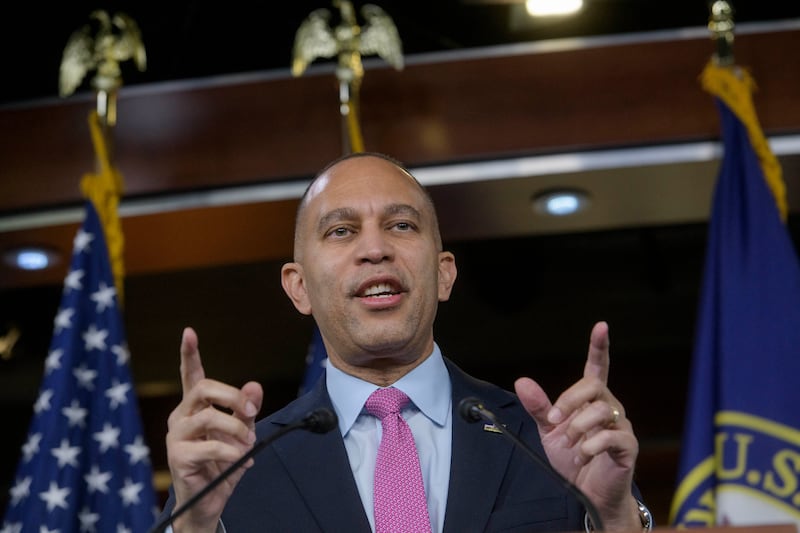WASHINGTON — Once a powerful political procedure usually carried out in secret, congressional redistricting has now become a public issue as both Democrats and Republicans openly explore adjusting district boundaries to gain an advantage in next year’s midterm elections.
Every state must update its congressional maps every decade following the release of new population data from the U.S. Census. The creation of districts is based on population numbers, and states are directed to establish boundaries that include approximately equal numbers of people while meeting demographic standards like racial equity.
The most recent census took place in 2020, with the final data released to states in 2021. Following this, states had to redraw their district lines prior to the 2022 midterm elections — a complex procedure that frequently faces legal disputes and efforts by dominant political parties to create maps that benefit their interests.
The redrawing of district boundaries usually occurs every ten years. However, currently, House Republicans and Democrats are exploring chances to change the maps before the 2026 midterm elections as there is a fierce competition for power in Washington.
Although both sides have engaged in partisan redistricting before, it has typically occurred behind closed doors and presented as nonpartisan policy. However, the current process is being discussed openly — and exposing the parties to claims of inconsistency.
Trump calls for adjustments to Texas map before midterm elections

The Texas state legislature is scheduled to meet this weekto start evaluating modifications to its congressional district map in response to requests from President Donald Trumpto set up as many as four or fivemore Republican House seats in the coming year.
Texas will be the largest one,” Trump stated earlier this month in response to questions about the potential for creating more conservative-leaning districts. “And that will be five.
The legislature is scheduled to hold an emergency session to tackle the severe floods that affected the state earlier this month, although state Republicans have suggested they will also take the chance to advocate for revised congressional districts.
The Republican Party currently has a 219-212 advantage in the U.S. House of Representatives, which represents an unusually narrow lead that has frequently hindered the party’s ability to pass bills even when they have a Republican trifecta. Having control of the White House and Senate, Republicans have had full authority over Washington — a situation that could change in November.
Historical patterns indicate that the political party of the current president usually loses its hold on the House of Representatives during midterm elections. Should the Democrats succeed in taking over the House, it would significantly weaken Trump’s position and likely hinder his plans for the remaining two years of his term.
Consequently, Trump is urging state Republican officials to secure more seats via redistricting — a move that some Democratic strategists view as an indication of political desperation.
Trump’s most recent approval numbers have decreased since he assumed office in January, dropping to 44.6% as of July 14,according to YouGov.
If it’s similar to that on Election Day next year, the Republicans will lose the House, and they’re wise enough to realize that,” Brad Bannon, a Democratic strategist, said to the Deseret News. “So what’s their move? They’ll attempt redistricting in Texas and aim to establish five additional GOP seats.
Democrats warn of retaliation — even with potential for hypocrisy

With Republicans set to fully commit to redrawing Texas’ maps, Democrats have suggested they may respond with their own adjustments — despite their own challenges.historically low approval ratings.
“Two can play this game,” said California Governor Gavin Newsom in a post on X.
House Minority Leader Hakeem Jeffries, a Democrat from New York, has also considered this approach — extending it to states outside of California. The leading House Democrat mentioned he would hold discussions with state representatives to “examine the potential and options available to ensure that the congressional map in 2026 is as equitable as possible.”
More information is not yet available, but Jeffries indicated that discussions were taking place — possibly even in his home state of New York.
However, Democratic counteractions might lead to accusations of inconsistency, as the party has consistently criticized Republican members for using partisan gerrymandering to influence elections.
Walter Olson, a senior fellow at the Cato Institute who focuses on constitutional issues, stated that altering district lines during a census cycle has long been viewed with skepticism. However, the discussion surrounding this issue is evolving, as political retaliation is becoming more accepted, according to him.
I believe it’s part of the broader shift in national politics over the past few years, where people have stopped feeling the need to present things with appealing principles,” Olson said to the Deseret News. “So much of it is now about revenge rather than ‘I think I can show they broke the law.’ Now we jump straight to a mindset of ‘They tried to charge me, so I’m going to try to charge them back.’
However, Democrats claim that redistricting is acceptable—particularly if Republicans proceed with proposals to modify the Lone Star State.
I believe it’s reasonable for Democrats to respond in California or Illinois or any other place they can,” Bannon stated regarding Democratic actions. “I think it would be ideal if everyone keeps the districts as they are. But you know, the truth is, if Texas wants to engage in games, I think Democrats should defend themselves however they can.
Numerous difficulties exist for the newly drawn Democratic maps.
However, these threats of retaliation might be simpler to express than to implement. Every state has its own procedures for modifying congressional districts, and it could be impractical to enact significant changes before the 2026 elections.
For instance, California enforces rigorous regulations regarding redistricting, which might complicate efforts by Democrats to modify district lines prior to the upcoming November election. State legislation prohibits redistricting during the decade, implying that a constitutional amendment would probably be required to implement any alterations.
Even so, state law mandates that California use an independent redistricting commission to create the maps, which involves a thorough review process and is intended to minimize political influence.
Democrats might consider other states for new voting maps, but many have comparable limitations on adjusting them during the decade — potentially complicating efforts to change election results.
Republicans encounter additional difficulties — such as public disapproval from voters
However, Republicans are expected to encounter certain difficulties in Texas as well. While they might not deal with as many legal or political barriers, they could face some resistance from voters—possibly endangering their majority regardless.
In 2011, the state legislature attempted to redraw the congressional map to create Republican-friendly districts, but these were later won by Democrats during the so-called “blue wave” in 2018. Because of this, state Republicans took a more cautious approach when they revised the map in 2021 to maintain GOP-controlled areas.
Now, if Republicans try to significantly alter the maps, they might encounter a comparable loss in 2026.
My own term for it is the ‘tippy boat problem,’ because you can only go so far before risking the capsizing of many boats at once,” Olson said. “You need a lot of boats to be tippy if you want to pull this off.
The “tippy boat problem” is known by another name in political discussions: Dummymandering. This occurred in 2018 as previously secure seats gradually became more vulnerable, providing an edge to the Democrats.
Even if Republicans manage to retain those districts in the upcoming year, the majority party will encounter an even more significant challenge — one that might trouble them for many years ahead.
If the Republicans are to gain so many new seats, they would need to (create) districts that would become a national joke and could even surpass some of the most extreme cases of gerrymandering we’ve witnessed before,” Olson stated. “They must be concerned about public reaction from voters. I believe gerrymandering is particularly disliked by well-educated voters and those in suburban areas — which includes many Texas voters that the Republicans need to maintain support from.







